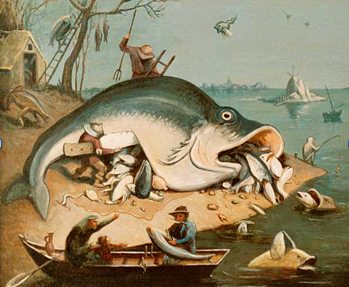
Big Fish Eat Small Fish!
Today was a perfect day – blue sky and sea – radiant sunshine and a calm surface on the water allowing the light to penetrate deep into the aquamarine depths. It was a day to have lunch on deck and our wonderful galley crew did us proud, bringing a complete barbeque plus salad, sweets and fruit up onto the deck so we could all eat in the sunshine. To top it all, nature put on a show too!
All day there has been a huge shoal of fish swimming back and forth alongside the ship. They obviously belonged to the family Scombridae that includes 51 species of tuna, mackerel and bonitos of varying sizes. The ones we saw were about half a metre long. As they moved, every so often one would twist momentarily onto its side giving a brilliant flash that lit up the water like a shower of quicksilver. Most of the shoal was swimming just below the surface, every detail of their bodies crystal clear, while occasionally a flash of light much deeper down indicated that there were many more fish than could be seen at the surface, and possibly something else deep down that kept these fish pinned to the surface.
Scombrids are generally predators of the open ocean, and are found worldwide in tropical and temperate waters. They are capable of considerable speed, due to a highly streamlined body and retractable fins. Some members of the family, in particular the tunas, are notable for being partially endothermic (warm-blooded), a feature that also helps them to maintain high speed and activity. It also means that they need a high calorific intake – perhaps as much as a quarter of their bodyweight daily. Other adaptations include a large amount of red muscle, allowing them to maintain activity over long periods. This dark muscle, and also the fact that they contain high levels of healthy omega oils, means that they are a desirable and healthy food, and the demand for them has therefore increased dramatically in recent years which has pushed some of the larger species to the brink of danger.
So why did these fish stay so close to the ship all day? Bob’s suggestion was that because we have been in one place for so long that we are now (un)officially a reef! But there was another reason that became very clear once nighttime took hold. Deeper down, hiding below the smaller fish, were big ones! They were also a Scombrids, but 4-5 times larger than the others! Once the moon had come up they shoaled the small fish time and time again towards the ship. We stood and watched this example of ‘nature, red in tooth and claw’ for a long time. The smaller fish huddling together for protection and then streaming off between two closing larger fish, and then splitting up and heading off into the dark, before being herded back again and again. There were thousands of smaller fish during the daytime, but while we watched, the hundred or so larger fish gradually picked them off, one by one, flashing as the moon caught their flanks when they turned quickly, a tactic used to mesmerize the shoaling fish and confuse them about their direction.
Big fish eat smaller fish, and the larger tuna in their turn have to be aware of their surroundings in case the ultimate ocean predator is attracted to this new artificial ‘reef’ – sharks! Sharks are perfectly adapted to their environment which is why they have survived for over 400 million years, since the Devonian period, through 5 mass extinctions, whereas the Scombrids have been around for a mere 55 million years, since the early Eocene.
Breugel, a Netherlandish artist, made a wonderful sketch of ‘The Big Fishes Eat the Little Fishes in 1556, based on an old Flemish proverb (much of his work was based on proverbs) perfectly illustrating how voracious these big marine carnivores are – they will gorge themselves while there is easily available food especially those species, like the Scombrids, which need a high calorie intake to maintain a higher than ambient body temperature.
It was quite a spectacle but eventually we had to come indoors again and leave then to their deathly moonlit dance. I wonder how many smaller fish will be left tomorrow morning?